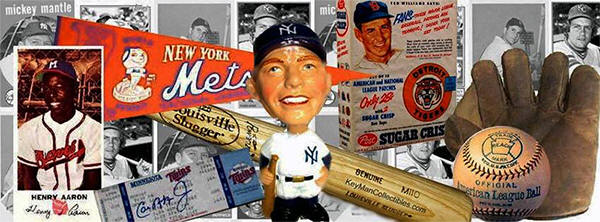|
|
|
|
| KeyMan
Collectibles |
NEWSLETTER |
December 2019 |
|
|
Official
Batting Order Lineup Cards
-
By Steven KeyMan |
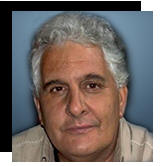 |
|
Steven KeyMan |
|
|
|
|
Founder of
Keymancollectibles.com,
and a long time
collector, Steven
KeyMan has more than 30
years of experience in
researching, and
cataloging information
on Baseball
Memorabilia.
Researching his own personal
collection, and helping others find
information on their
collectibles, the
website grew into the
largest online resource
for baseball
memorabilia |
|
|
|
|
|
| |
Ask
Steven: Direct your questions or feedback,
about Baseball Memorabilia to Steven KeyMan
Steve@keymancollectibles.com You can also Send
KeyMan pictures of your personal Memorabilia Display,
and get your own Free
Collectors Showcase Room featured on the website.. |
|
|
|
|
In the early days of organized
baseball, the rules did not require
that the batting order be announced
before game time. This permitted
strategic decisions regarding
batting order to occur while the
game was in progress. Rule V, Sec.
2 of the 1876 Playing Rules of the
National League of Professional
Base Ball Clubs states: "The
batsmen must take their positions
in the order on which they are
named on the score-book. After the
first innings, the first striker in
each innings shall be the batsman
whose name follows that of the
third man out in the preceding
innings."
|
|
| |
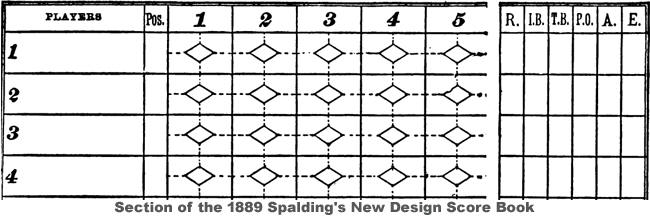 |
|
| |
During the 1880s, organized
baseball began mandating that the
batting order be disclosed before
the first pitch. It was not until
1889 that the National league
sufficiently defined Rule 19
stating: "The printed or written
order of batting, which each
captain of the contesting team
presents to the umpire prior to the
commencement of the game; and such
order, on approval of the umpire,
should be copied verbatim in the
score book of the official scorer
of the game, as the official copy,
to the secretary of the League or
Association the club belongs to."
 It has always been stated in
rule 19; that the batting order of
each team must be delivered to the
umpire before the game who shall
submit it to the inspection of the
captain of the other side. But its
not until 1910 when it is stated in
Rule 39 - that the batting order of
each team must be delivered before
the game by it's captain to the
umpire at home plate. This revision
marks the beginning of the pre-game
ritual of swapping official batting
orders, and going over the ground
rules with the umpire at home
plate.
It has always been stated in
rule 19; that the batting order of
each team must be delivered to the
umpire before the game who shall
submit it to the inspection of the
captain of the other side. But its
not until 1910 when it is stated in
Rule 39 - that the batting order of
each team must be delivered before
the game by it's captain to the
umpire at home plate. This revision
marks the beginning of the pre-game
ritual of swapping official batting
orders, and going over the ground
rules with the umpire at home
plate.
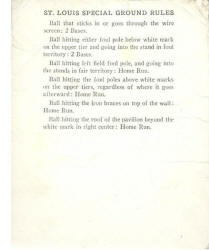 It is not known when pre-printed
official batting order cards were
first used. The oldest Lineup cards
to surface into the hobby are from
the 1930's. After the cards are
submitted to the umpire by the
manager or coach of each team
before the game they go over the
ground rules. Some that are unique
to the home teams ballpark are
listed and printed on the back. The
umpire keeps one copy of the lineup
card of each team, and gives the
second copy to the opposing
manager. A copy is also sent to the
official scorer but it's not clear
on who provides it.
It is not known when pre-printed
official batting order cards were
first used. The oldest Lineup cards
to surface into the hobby are from
the 1930's. After the cards are
submitted to the umpire by the
manager or coach of each team
before the game they go over the
ground rules. Some that are unique
to the home teams ballpark are
listed and printed on the back. The
umpire keeps one copy of the lineup
card of each team, and gives the
second copy to the opposing
manager. A copy is also sent to the
official scorer but it's not clear
on who provides it.
 The value for batting order lineup
cards will vary based on age, the
lineup for that game, the signature
of the manager on the original
copy, team, stadium, and
accomplishments of noted players
for that game. As with all
collectibles condition is important
but the crease caused by folding is
normal.
The value for batting order lineup
cards will vary based on age, the
lineup for that game, the signature
of the manager on the original
copy, team, stadium, and
accomplishments of noted players
for that game. As with all
collectibles condition is important
but the crease caused by folding is
normal.
This "Official Batting Order" Lineup Card for the visiting club is from
the
game played on May 21, 1934, at
St. Louis' Sportsman's Park. The
undated batting order card was
filled out by Connie Mack in pencil
and signed at the bottom.
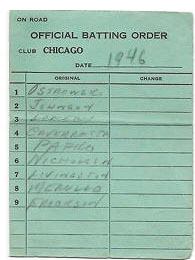 For the most part but not true in
every example found since the
1940's, "On Road" official batting
order cards were printed with a
blue or greenish tint, with the
home team printed in white,
beige or a lighter tint. It seems that most
clubs carried their own lineup
cards when on the road.
For the most part but not true in
every example found since the
1940's, "On Road" official batting
order cards were printed with a
blue or greenish tint, with the
home team printed in white,
beige or a lighter tint. It seems that most
clubs carried their own lineup
cards when on the road.
These
cards will not have the ground
rules printed on the back. There are also examples found that were provided to the visiting club by
the home team, which do not have a
team name at the top or reads
"Visiting Club" and will have
the ground rules on the back.
 There
are standard formats used in
printing the official batting order
cards that could be attributed to
specific eras. The printing style
used for lineup cards from the
1930's (see 1934 card above) leaks
into the 1940's. By 1946 the format
was changed as seen in the example
above. Sometime around 1954 another
change was made. It was not
mandatory to use one format or the
other, and as shown here these two
1954 New York Giants lineup cards
were used in the same year. They
used up the older cards before
using the new. It is common to find
cards without a date. There
are standard formats used in
printing the official batting order
cards that could be attributed to
specific eras. The printing style
used for lineup cards from the
1930's (see 1934 card above) leaks
into the 1940's. By 1946 the format
was changed as seen in the example
above. Sometime around 1954 another
change was made. It was not
mandatory to use one format or the
other, and as shown here these two
1954 New York Giants lineup cards
were used in the same year. They
used up the older cards before
using the new. It is common to find
cards without a date.
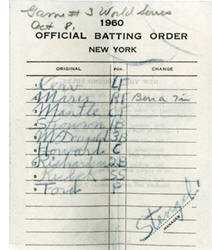 Carbon
copies show up around 1960, as seen
with this World Series game 3
lineup copy featured in a 2005
Heritage Auction.
The format used in the printing for
this lineup card differs from the
cards common to after 1965. It has a
diagonal manager line at the bottom
right as seen with the cards
printed in the 1930's, but with a
different header. Carbon
copies show up around 1960, as seen
with this World Series game 3
lineup copy featured in a 2005
Heritage Auction.
The format used in the printing for
this lineup card differs from the
cards common to after 1965. It has a
diagonal manager line at the bottom
right as seen with the cards
printed in the 1930's, but with a
different header.
The paper used is also thinner. Carbon copies will have a lower collectors
value than the original which
features the actual signature of
the manager.
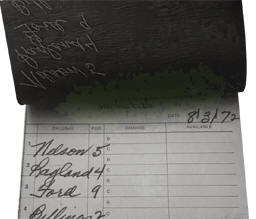 The 1972 Official Batting Order
cards came in a 4 part carbon copy
pad that consisted of 4 sheets like
this one filled out by Ted Williams
and used for this Texas Rangers
lineup.
The 1972 Official Batting Order
cards came in a 4 part carbon copy
pad that consisted of 4 sheets like
this one filled out by Ted Williams
and used for this Texas Rangers
lineup.
The original on the top was filled out by the manager which made 3 carbon
copies, one for the manager to
keep, one for the umpire, one for
the opposing manager, and one for
the official scorekeeper.
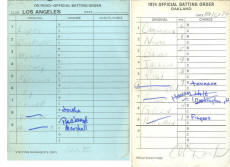 The examples shown here are from
game 3 of the 1974 World Series
between the visiting club, Los
Angeles Dodgers, and the home team
Oakland Athletics. The "On
Road-Official Batting" card used by
Los Angeles for this game has a
different printing format than the
"1974 Official Batting Order" card
used by Oakland.
The examples shown here are from
game 3 of the 1974 World Series
between the visiting club, Los
Angeles Dodgers, and the home team
Oakland Athletics. The "On
Road-Official Batting" card used by
Los Angeles for this game has a
different printing format than the
"1974 Official Batting Order" card
used by Oakland.
The Lineup card used by the
Athletics is the same format used
in the 1985 Exhibition Stadium game
below. The Los Angeles "Visiting
Managers copy" and the Oakland
"Official Scorer's Copy" were both
used by the home plate umpire Doug
Harvey. Little attention was paid
to who received which copy.
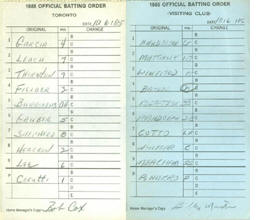 These "1985
Official Batting Order" Lineup
Cards are from the game played on
October 6th, at Toronto's
Exhibition Stadium. In this the
last game of the 1985 season,
Yankees MVP Don Mattingly hit Home
run 35, and Phil Niekro became the
18th pitcher in Major League
history to win 300 games. The
46-year-old knuckleballer also
became the oldest pitcher in
baseball history to toss a shutout,
when the Yankees beat the Blue Jays
8-0.
These "1985
Official Batting Order" Lineup
Cards are from the game played on
October 6th, at Toronto's
Exhibition Stadium. In this the
last game of the 1985 season,
Yankees MVP Don Mattingly hit Home
run 35, and Phil Niekro became the
18th pitcher in Major League
history to win 300 games. The
46-year-old knuckleballer also
became the oldest pitcher in
baseball history to toss a shutout,
when the Yankees beat the Blue Jays
8-0.
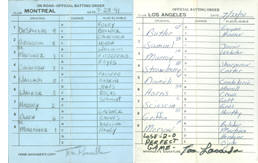 These 1990's era Official Batting
Order lineup cards; are from the
game played at
Dodger Stadium on
July 28, 1991, when Montreal Expos
pitcher Dennis Martínez pitched a
perfect game against the Los
Angeles Dodgers. These copies
belonged to Tommy Lasorda, where he
made the notation "Lose-2-0 Prefect
Game-"
These 1990's era Official Batting
Order lineup cards; are from the
game played at
Dodger Stadium on
July 28, 1991, when Montreal Expos
pitcher Dennis Martínez pitched a
perfect game against the Los
Angeles Dodgers. These copies
belonged to Tommy Lasorda, where he
made the notation "Lose-2-0 Prefect
Game-" |
|
| |
|
|
| |
 |
Through
the years there have been
errors made filling out the
lineup, as was the case
with a game played on
August 28, 1988. Before the
game between Detroit and
Milwaukee, Brewers manager
Tom Trebelhorn meant to put
newly acquired Mike Young
into the 5th spot of his
lineup card.
But out of habit, when he wrote "Y-o-u-n," he automatically put a "t"
instead of a "g" on the end
of the name. That's Yount,
as in Robin, the veteran
Brewer whom Trebelhorn
already had listed in the
third spot.
Rule 4.01 section d
states in part:
Obvious errors in the
batting order, which are
noticed by the
umpire-in-chief before he
calls 'play' for the start
of the game, should be
called to the attention of
the manager or captain of
the team in error, so the
correction can be made
before the game starts....
Teams should not be trapped
later by some mistake that
obviously was inadvertent
and which can be corrected
before the game starts. |
|
|
| |
Home plate umpire Mike Reilly made
the mistake in not noticing that "Yount"
was listed in the third spot as the
center fielder and the fifth spot
as the DH. But when Tigers manager
Sparky Anderson returned to the
dugout from the pre-game meeting at
home plate, he handed the lineup
card to Dick Tracewski who noticed
the error. Anderson waited until
Young came to bat in the 5th spot,
then called the mistake to the
attention of the umpires.
After first deciding to overlook the error, the umpires sided with
Anderson and ordered Yount out of
the game. Trebelhorn was ejected
for arguing, and played the rest of
the game under protest. Because the
Brewers won, the protest is
canceled. But had the Tigers won,
it seems the protest could have
been upheld by American League
president Bobby Brown. The game
would then have been resumed from
the point of protest. "Teams should
not be trapped later by some
mistake that obviously was
inadvertent and which can be
corrected before the game starts." |
|
| |
|
|
| |
"Game-Used" Official Batting Order
lineup cards are unique to each
game played, and hard to come by.
Most are made available to the
collectors market through estate
sales, or collections from ex-managers, and umpires.
A collector coming across a lineup
card of interest, might never see
another again. Chances are that one
of the other 2 copies will never
hit the market. And, the original
filled out by the manager could be
one-of-a-kind. |
|
| |
|
|
| |
KEYMAN COLLECTIBLES
RELATED RESOURCES |
|
| |
|
|
| |
KeyMan
Collectibles Collectors Corner
- Keep up with the latest collecting news,
announcements, and articles of interest on the
webs best resource for baseball memorabilia. |
|
| |
KeyMan Collectibles Baseball
Memorabilia Facebook Group -
Post Questions and comments relating to
Baseball Collectibles and Memorabilia. Interact
with other collectors or show off your
collection. |
|
| |
KeyMan
Collectibles Forum
- A great option for those that "Don't do
facebook" Post Questions and
comments relating to Baseball Collectibles and
Memorabilia |
|
|
|
|
|

